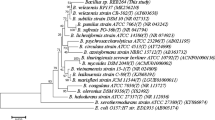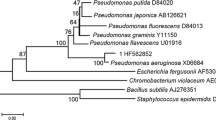Abstract
This study’s aim was to determine the identity of antibacterial compounds produced by Pseudomonas aeruginosa strain UICC B-40 and describe the antibacterial compounds’ mechanisms of action for damaging pathogenic bacteria cells. Isolation and identification of the compounds were carried out using thin layer chromatography (TLC), nuclear magnetic resonance (NMR) spectroscopy and liquid chromatography mass spectrometry (LC-MS) analyses. Antibacterial activity was assayed via minimum inhibitory concentration (MIC) and the antibacterial compound mechanism was observed morphologically through scanning electron microscopy (SEM). This study successfully identified the (2E,5E)-phenyltetradeca-2,5-dienoate antibacterial compound (molecular weight 300 g/mol), composed of a phenolic ester, fatty acid and long chain of aliphatic group structures. MIC values for this compound were determined at 62.5 μg/ml against Staphylococcus aureus strain ATCC 25923. The mechanism of the compound involved breaking down the bacterial cell walls through the lysis process. The (2E,5E)-phenyltetradeca-2,5-dienoate compound exhibited inhibitory activity on the growth of Gram-positive bacteria.
Similar content being viewed by others
References
Berdy, J. 2005. Bioactive microbial metabolites (review article). J. Antibiot. 58, 1–26.
Borges, A., Ferreira, C., Saavedra, M.J., and Simöes, M. 2013. Antibacterial activity and mode of action of ferulic and gallic acids against pathogenic bacteria. Microb. Drug Resist. 19, 1–10.
Boughton, B.W. and Pollock, M.R. 1952. Long-chain unsaturated fatty acids as essential bacterial growth factors: further studies with Corynebacterium ‘Q’. Biochem. J. 53, 261–265.
Cappuccino, J.G. and Sherman, N. 1999. Microbiology: a laboratory manual, pp. 263–264. Benjamin-Cummings Pub Co., USA.
Dawood, K.F. 2012. A study of antibacterial activity of fatty acids extracted from Pseudomonas sp. LP1 by using chromatography technique. J. Univ. Anbar Pure Sci. 6, 40–45.
Desbois, A.P. 2012. Potential applications of antimicrobial fatty acids in medicine, agriculture and other industries. Recent Pat. Antiinfect. Drug Discov. 7, 111–122.
Desbois, A.P. and Smith, V.J. 2010. Antibacterial free fatty acids: activities, mechanisms of action and biotechnological potential. Appl. Microbiol. Biotechnol. 85, 1629–1642.
El-Deeb, B., Khalaf, F., and Youssuf, G. 2013. Isolation and characterization of endophytic bacteria from Plectranthus tenuiflorus medicinal plant in Saudi Arabia desert and their antimicrobial activities. J. Plant Interact. 8, 56–64.
El-Shouny, W.A., Al-Baidani, A.R., and Hamza, W.T. 2011. Antimicrobial activity of pyocyanin produced by Pseudomonas aeruginosa isolated from surgical wound-infections. Int. J. Pharm. Med. Sci. 1, 1–7.
Galbraith, H. and Miller, T.B. 1973. Effect of long-chain fatty acids on bacterial respiration and amino acid uptake. J. Appl. Bacteriol. 36, 659–675.
Hakim, S.T., Arshed, S., Iqbal, M., and Javaid, S.G. 2007. Vancomycin sensitivity of Staphylococcus aureus isolates from hospital patients in Karachi, Pakistan. Libyan J. Med. 2, 176–179.
Heath, R.J., White, S.W., and Rock, C.O. 2001. Lipid biosynthesis as a target for antibacterial agents. Prog. Lipid Res. 40, 467–497.
Hwang, B.K., Lim, S.W., Kim, B.S., Lee, J.Y., and Moon, S.S. 2001. Isolation and in vivo and in vitro antifungal activity of phenyl acetic acid and sodium phenyl acetate from Streptomyces humidus. Appl. Environ. Microbiol. 67, 3739–3745.
Kai, J., Matoh, M., and Tsukidate, K. 1999. A new method for preparing electron microscopic specimens of Helicobacter pylori. Med. Electron Microsc. 32, 62–65.
Leisinger, T. and Margraff, R. 1979. Secondary metabolites of fluorescent pseudomonads. Microb. Rev. 43, 422–442.
Lodewyckx, C., Vangronsveld, J., Porteous, F., Moore, E.R.B., Taghavi, S., Mezgeay, M., and van der Lelie, D. 2002. Endophytic bacteria and their potential applications. Crit. Rev. Plant Sci. 21, 583–606.
Matthijs, S., Wauven, V.C., Cornu, B., Ye, L., Cornelis, P., Thomas, C.M., and Ongena, M. 2014. Antimicrobial properties of Pseudomonas strains producing the antibiotic mupirocin. Res. Microbiol. 165, 695–704.
Menpara, D. and Chanda, S. 2013. Endophytic Bacteria–Unexplored Reservoir of Antimicrobials for Combating Microbial Pathogens, pp. 1095–1103. In Méndez-Vilaz, A. (ed.), FORMATEX Microbiology Series 4–Microbial pathogens and strategies for combating them: science, technology and education. Formatex Research Center, Badajoz, Spain.
Nimnoi, P. and Pongslip, N. 2009. Genetic diversity and plantgrowth promoting ability of the indole-3-acetic acid (IAA) synthetic bacteria isolated from agricultural soil as well asrhizosphere, rhizoplane and root tissue of Ficus religiosa L., Leucaena leucocephala, Piper sarmentosum Roxb. Res. J. Agricul. Biol. Sci. 5, 29–41.
Palleroni, N.J. 1992. Present situation of the taxonomy of aerobic pseudomonads. In Galli, E., Silver, S., and Witholt, B. (eds.), Pseudomonas: Molecular Biology and Biotechnology, pp. 105–115. ASM Press. Washington, DC, USA.
Parekh, J., Karathia, N., and Chanda, S. 2006. Screening of some traditionally used medicinal plants for potential antibacterial activity. Indian J. Pharm. Sci. 68, 832–834.
Pohl, C.H., Kock, J.L.F., and Thibane, V.S. 2011. Antifungal free fatty acids: A Review, pp. 61–71. In Méndez-Vilaz, A. (ed.), FORMATEX Microbiology Series 3–Science against microbial pathogens: communicating current research and technological advances. Formatex Research Center, Badajoz, Spain.
Pollock, M.R., Howard, G.A., and Boughton, B.W. 1949. Longchain unsaturated fatty acids as essential bacterial growth factors; substances able to replace oleic acid for the growth of Corynebacterium “Q” with a note on a possible method for their microbiological assay. Biochem. J. 45, 417–422.
Pratiwi, R.H., Hidayat, I., Hanafi, M., and Mangunwardoyo, W. 2016. Identification and characterization of three endophytic bacteria from Neesia altissima (Malvaceae) antagonistic to diarrhea-causing bacteria. Malays. J. Microbiol. 12, 300–307.
Rattan, A., Kalia, A., and Ahmad, N. 1998. Multidrug-resistant Mycobacterium tuberculosis: molecular perspectives. Emerg. Infect. Dis. 4, 195–209.
Ruiz, B., Chávez, A., Forero, A., García-Huante, Y., Sánchez, M., Rocha, D., Sánchez, B., Romero, A., Rodríguez-Sanoja, R., Sánchez, S., et al. 2010. Production of microbial secondary metabolites: regulation by the carbon source. Crit. Rev. Microbiol. 36, 146–167.
Seidel, V. and Taylor, P.W. 2004. In vitro activity of extracts and constituents of Pelargonium against rapidly growing mycobacteria. Int. J. Antimicrob. Agents 23, 613–619.
Sheu, C.W. and Freese, E. 1973. Lipopolysaccharide layer protection of Gram-negative bacteria against inhibition by long chain fatty acids. J. Bacteriol. 115, 869–875.
Strobel, G.A. and Daisy, B. 2003. Bioprospecting for microbial endophytes and their natural products. Microbiol. Mol. Biol. Rev. 67, 491–502.
Sun, C.Q., O’Connor, C.J., and Roberton, A.M. 2003. Antibacterial actions of fatty acids and monoglycerides against Helicobacter pylori. FEMS Immunol. Med. Microbiol. 36, 9–17.
Togashi, N., Shiraishi, A., Nishizaka, M., Matsuoka, K., Endo, K., Hamashima, H., and Inoue, Y. 2007. Antibacterial activity of longchain fatty alcohols against Staphylococcus aureus. Molecules 12, 139–148.
Van Bambeke, F., Reinert, R.R., Appelbaum, P.C., Tulkens, P.M., and Peetermans, W.E. 2007. Multidrug-resistant Streptococcus pneumoniae infections: current and future therapeutic options. Drugs 67, 2355–2382.
Waters, A.E., Contente-Cuomo, T., Buchhagen, J., Liu, C.M., Watson, L., Pierce, K., Foster, J.T., Bowers, J., Driebe, E.M., Engelthaler, D.M., et al. 2011. Multidrug-resistant Staphylococcus aureus in US meat and poultry. Clin. Infect. Dis. 52, 1227–1230.
Zanatta, Z.G.C., Moura, A.B., Maia, L.C., and Santos, A.S. 2007. Bioassay for selection of biocontroller bacteria against bean common blight (Xanthomonas axonopodis pv. phaseoli). Braz. Microbiol. 38, 511–515.
Zheng, C.J., Yoo, J., Lee, T., Cho, H., Kim, Y., and Kim, W. 2005. Fatty acid synthesis is a target for antibacterial activity of unsaturated fatty acids. FEBS Lett. 579, 5157–5162.
Author information
Authors and Affiliations
Corresponding author
Rights and permissions
About this article
Cite this article
Pratiwi, R.H., Hidayat, I., Hanafi, M. et al. Antibacterial compound produced by Pseudomonas aeruginosa strain UICC B-40, an endophytic bacterium isolated from Neesia altissima . J Microbiol. 55, 289–295 (2017). https://doi.org/10.1007/s12275-017-6311-0
Received:
Revised:
Accepted:
Published:
Issue Date:
DOI: https://doi.org/10.1007/s12275-017-6311-0




